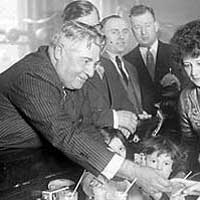Gangsters
Michael O'Malley, Associate Professor of History and Art History, George Mason University
Introduction

Organized or semi-organized crime has a long history in the United States. Organized gangs of counterfeiters or thieves could be found in colonial America, and there have always been criminal organizations among unscrupulous businessmen. But in popular culture “gangsters” are closely associated with immigrant groups.
New immigrants to the United States have often found themselves on the outside--ostracized to some extent by natives, working in low wage jobs, isolated from the culture they grew up in. They often found themselves excluded from police protection, from access to credit, and from conventional business opportunities. In the 1830s, urban immigrants began organizing themselves into gangs. These gangs sometimes provided services, like loans or jobs protection from crime, that immigrant neighborhoods could not otherwise get. They also sometimes exploited those same people—intimidating honest citizens, promoting vice, and controlling the political process. As mentioned in class, before the Civil War volunteer fire companies straddled the line between “gangs” and public service.
By the early twentieth century, “gangsters” were mostly Irish, Jewish or Italian Americans in northern industrial cities. They were well known for their flamboyant style and their contempt for convention. The passage of prohibition in 1919 increased the public visibility of gangsters, as organized crime rushed to fill the void left when alcohol consumption became illegal. By then, movies, fiction, and the especially the popular press had seized on “gangsters” as sensational, popular figures. Many gangsters came to enjoy and exploit this notoriety. The Library of Congress has put the photo archives of the Chicago Daily News online. This assignment asks you to explore the Library of Congress collections around the term “gangster.”
Updated | April 2004
